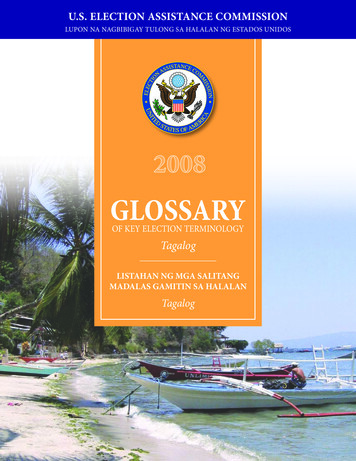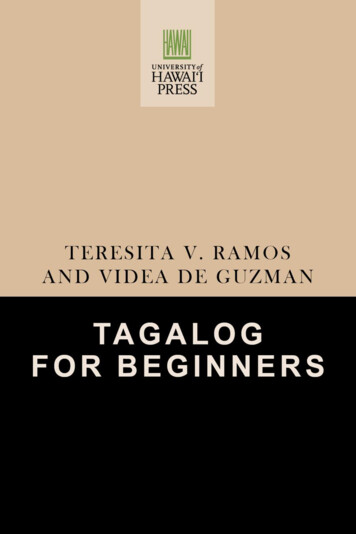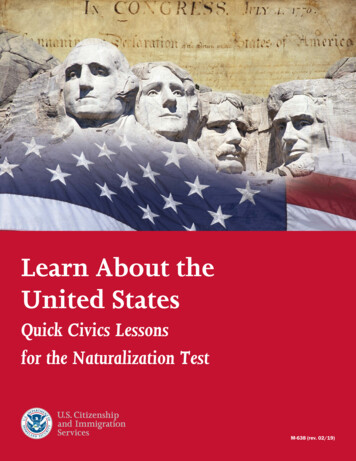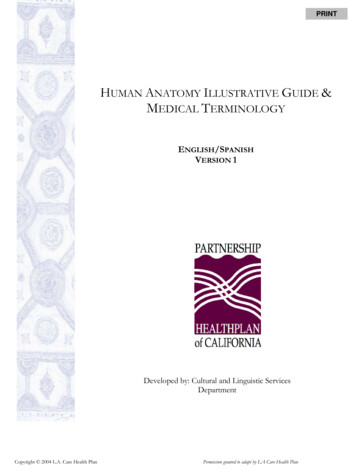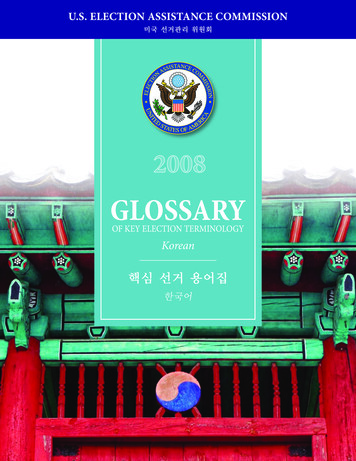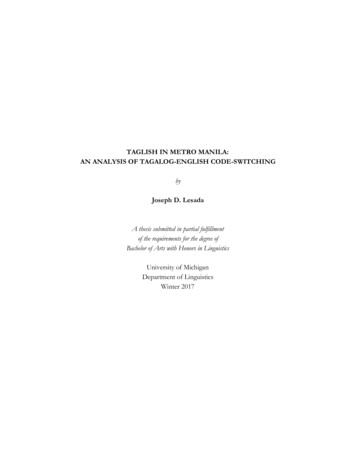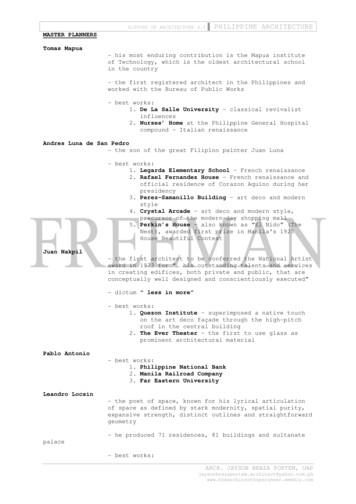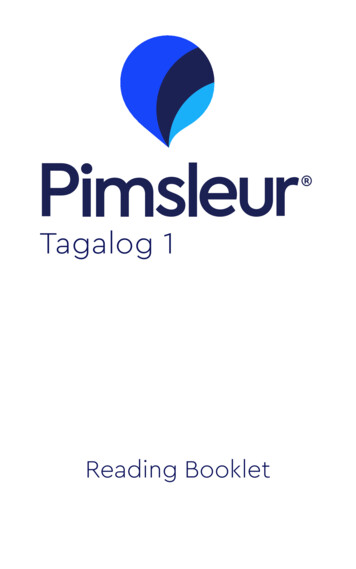
Transcription
Tagalog 1Reading Booklet
Tagalog 1Travelers should always check with theirnation's State Department for currentadvisories on local conditions beforetraveling abroad.Booklet Design: Maia Kennedy and ‰ Recorded Program 2007 Simon & Schuster, Inc. Reading Booklet 2007 Simon & Schuster, Inc.Pimsleur is an imprint of Simon & Schuster Audio,a division of Simon & Schuster, Inc. Mfg. in USA.All rights reserved.ii
Tagalog 1ACKNOWLEDGMENTSVoicesEnglish-Speaking Instructor . . . . . . . . . . . Ray BrownTagalog-Speaking Instructor. . . . . . . . Mitch De LeonFemale Tagalog Speaker . . . . . . . . . . . . . Lisa RussellMale Tagalog Speaker . . . . Francesco PangalanganCourse WritersWarren Tan Marie-Pierre Grandin-GilletteReviewerPaz MendozaEditorsJoan Schoellner Beverly D. HeinleExecutive ProducerBeverly D. HeinleProducer & DirectorSarah H. McInnisRecording EngineersPeter S. Turpin Kelly SauxSimon & Schuster Studios, Concord, MAiii
Tagalog 1Table of ContentsThe Tagalog Language . . . . . . . . . . . . . . . . . . . . . . . . . . . .Stress . . . . . . . . . . . . . . . . . . . . . . . . . . . . . . . . . . . . . . . . . . .Glottal Stop . . . . . . . . . . . . . . . . . . . . . . . . . . . . . . . . . . . . . .Diacritics . . . . . . . . . . . . . . . . . . . . . . . . . . . . . . . . . . . . . . . .Tapping . . . . . . . . . . . . . . . . . . . . . . . . . . . . . . . . . . . . . . . . .The Tagalog Alphabet . . . . . . . . . . . . . . . . . . . . . . . . . . . . .Relaxing “i” . . . . . . . . . . . . . . . . . . . . . . . . . . . . . . . . . . . . . .Spanish and English Loan Words . . . . . . . . . . . . . . . . . . . .Numbers . . . . . . . . . . . . . . . . . . . . . . . . . . . . . . . . . . . . . . . .Tagalog ay. . . . . . . . . . . . . . . . . . . . . . . . . . . . . . . . . . . . . . .Speaking Humbly and Intonation . . . . . . . . . . . . . . . . . . .1224678991111Lesson 1 . . . . . . . . . . . . . . . . . . . . . . . . . . . . . . . . . . . . . . . . .Lesson 2 . . . . . . . . . . . . . . . . . . . . . . . . . . . . . . . . . . . . . . . .Lesson 3 . . . . . . . . . . . . . . . . . . . . . . . . . . . . . . . . . . . . . . . .Lesson 4 . . . . . . . . . . . . . . . . . . . . . . . . . . . . . . . . . . . . . . . .Lesson 5 . . . . . . . . . . . . . . . . . . . . . . . . . . . . . . . . . . . . . . . .Lesson 6 . . . . . . . . . . . . . . . . . . . . . . . . . . . . . . . . . . . . . . . .Lesson 7 . . . . . . . . . . . . . . . . . . . . . . . . . . . . . . . . . . . . . . . .Lesson 8 . . . . . . . . . . . . . . . . . . . . . . . . . . . . . . . . . . . . . . . .Lesson 9 . . . . . . . . . . . . . . . . . . . . . . . . . . . . . . . . . . . . . . . .Lesson 10 . . . . . . . . . . . . . . . . . . . . . . . . . . . . . . . . . . . . . . . .Lesson 11 . . . . . . . . . . . . . . . . . . . . . . . . . . . . . . . . . . . . . . . .Lesson 12 . . . . . . . . . . . . . . . . . . . . . . . . . . . . . . . . . . . . . . . .Lesson 13 . . . . . . . . . . . . . . . . . . . . . . . . . . . . . . . . . . . . . . . .Lesson 14 . . . . . . . . . . . . . . . . . . . . . . . . . . . . . . . . . . . . . . . .Lesson 15 . . . . . . . . . . . . . . . . . . . . . . . . . . . . . . . . . . . . . . . .Lesson 16 . . . . . . . . . . . . . . . . . . . . . . . . . . . . . . . . . . . . . . . .Lesson 17 . . . . . . . . . . . . . . . . . . . . . . . . . . . . . . . . . . . . . . . .Lesson 18 . . . . . . . . . . . . . . . . . . . . . . . . . . . . . . . . . . . . . . . .Lesson 19 . . . . . . . . . . . . . . . . . . . . . . . . . . . . . . . . . . . . . . . .Lesson 20 . . . . . . . . . . . . . . . . . . . . . . . . . . . . . . . . . . . . . . .1314151617181920212223242526272829303132iv
Tagalog 1The Tagalog LanguageApproximately one-hundred and seventy languages are spoken in the Philippines, eight of whichare considered major. Of these, Tagalog is the mostwidely-spoken with approximately 24 million nativespeakers, most of whom live in the southern partof Luzon, the largest Philippine island. More thanone third of this population lives in the metropolitanarea of Manila, the Philippine capital. Tagalog is alsospoken as a second or third language by almost thetotal population of the Philippines. Several dialects ofTagalog are spoken in different regions, but the dialectspoken in Manila dominates the Philippine media andis the dialect taught in this course.Following a mandate of the 1935 PhilippineConstitution, the National Language Institute wasestablished in 1936 for “the study of Philippinedialects in general for the purpose of evolving andadopting a common national language based on oneof the existing native tongues.” Tagalog was recommended as the basis for this national language, andin 1987 the Philippine Constitution stipulated thatthis language be called “Filipino.” Filipino is primarilybased on Tagalog, and is sometimes describedas a standardized dialect of Tagalog. Althoughinitially unpopular among non-Tagalog speakingFilipinos, Filipino has been established, through theeducational system and mass media, as the linguafranca in the Philippines and abroad.
Tagalog 1Ten percent of the nearly 90 million Philippinepopulation works abroad. There are over onemillion Tagalog speakers in the United States. It isthe second most commonly-spoken Asian languageand the sixth most commonly spoken non-Englishlanguage in the United States. It is also a significantminority language in Canada, Guam, the UnitedKingdom, Australia, New Zealand, the Middle East,Hong Kong, and Singapore.StressIn Tagalog primary stress always occurs on eitherthe penultimate (second-to-last) or final syllable.Secondary stress can also occur in a word prior tothe penultimate syllable. A slight lengthening of thevowel accompanies stress, except when the stressoccurs at the end of a word. In Tagalog, the locationof syllable stress can determine the definition ofa word. In the statement Baka ang baka (or Bakáang baka), the first baka is stressed on the secondsyllable and means “perhaps”; the second is stressedon the first syllable and means “cow.”Glottal StopSome Tagalog words end in a quick pause or“glottal stop.” But these words end in the stop onlyif they are followed by a pause in speech, such as2
Tagalog 1a pause indicated by a punctuation mark. In a fewcases, adding a glottal stop can change the meaningof a word. For example, if the word bata is stressed onthe penultimate syllable and does not end in a glottalstop, it means “robe”; if the same word is stressed onthe penultimate syllable and ends in a glottal stop, itmeans “child.”On its own, the word bata or “child” ends in aglottal stop. In the sentence Ikaw ang bata, whichmeans “you’re the young one” or “you the child,”bata again ends in a glottal stop because it isfollowed by a pause. However, Bata ka pa (whichmeans “you’re still young” or “child you still”) doesnot end in a glottal stop because it is not followed bya pause. (The same pronunciation of bata can alsomean “robe,” as mentioned above.)A glottal stop is also used to separate adjacentvowels in Tagalog, whether they are in the same wordor in adjacent words in a sentence. However, in rapidspeech the glottal stop may be omitted. In this case,the adjacent vowels just run together.A hyphen that is followed by a vowel also indicatesa glottal stop, e.g. the hyphen in nag-aral.3
Tagalog 1DiacriticsTagalog diacritics, or accent marks, are not usedin everyday written Tagalog. However, you willsee them in dictionaries and language instructionmaterials. They are used to show where the stressoccurs in a word. The Reading Lessons will begin byincluding diacritics to help guide your pronunciation.As the lessons progress and you are reading wordsand phrases you have learned in the course, they willbe phased out.The Tagalog diacritics are shown in the chartthat follows.Diacritic(shown with “a”)StressNo MarkStress is on the penultimate, orsecond-to-last, vowel.AcuteAccent - áAccent Grave àIf either the penultimate or the finalvowel is marked, it receives primarystress. If a vowel before the penultimate vowel is marked, it receivessecondary stress.This mark appears on the final vowelin a word and indicates that thepenultimate vowel receives primarystress and that the marked finalvowel includes a glottal stop if theword is followed by a pause.4
Tagalog 1CircumflexâThis mark is on the final vowel in aword and indicates that the finalvowel is stressed and ends in aglottal stop, if the word is followedby a pause. Accent marks do not distinguish between primaryand secondary stress. Primary stress alwaysoccurs on the penultimate or final vowel/syllable. The acute accent can be used anywhere and morethan once in a word. The grave and the circumflex accents can only beused on the final vowel and only once in a word. If the final vowel is not marked with an acuteaccent or a circumflex, the penultimate vowel is,by default, stressed, whether or not it is markedby an acute accent. Vowel lengthening accompanies both primaryand secondary stress, except on the final vowel/syllable.In the examples below, the stressed syllable is in bold: batà (“child”)—the stress is on the penultimatevowel and it ends with a glottal stop (if followedby a pause).5
Tagalog 1 bata (“robe”)—the stress is on the penultimatevowel and it does not end in a glottal stop.Traditionally, this word would not be marked withany diacritic in dictionaries, although it may bemarked with an acute accent on the penultimatevowel and appear as báta. basâ (“wet”)—the stress is on the final vowel andit ends in a glottal stop (if followed by a pause). basá (“read”)—the stress is on the final vowel andit never ends in a glottal stop.TappingIn Tagalog, several words that start with a “d”undergo a change and start with an “r” if the worddoes not start a sentence clause and if it follows aword that ends in a vowel. These words are: daw,din, dito, diyan, doon.The process is called “tapping.” It producesa sound similar to the sound of the letter “t” in thegeneral American pronunciation of the word “water.”Often, however, particularly in slow speech, the“tapping” becomes a “rolling-r” sound. Doon ako pupunta. - Since the word in boldbegins a sentence clause, it starts with a “D.”6
Tagalog 1 Pupunta ako roon. - The same word in boldfollows a vowel and doesn’t start a sentenceclause; therefore, it starts with an “r.” Pupunta ka roon, pero doon din ako pupunta.- The first word in bold follows a vowel anddoesn’t begin a sentence clause, so it starts withan “r.” The second word in bold follows a vowel,but does begin a sentence clause, so it startswith a “d.” However, this rule is often broken incasual conversation.Tagalog AlphabetBefore the arrival of the Spaniards in thesixteenth century, Tagalog was written in a scriptcalled Baybayin, which was based on the SouthernIndian Brahmi script. Gradually, this script wasreplaced by the Latin Alphabet, which is used todayfor written Tagalog.The NG, which sounds like the “ng” in “sing,”can start a Tagalog word and is officially considereda letter. In the Tagalog alphabet, it comes after theletter “N.”The letters C, F, J, Ñ, Q, V, and Z are usedprimarily for proper nouns borrowed from Englishand Spanish.In English-derived words, these7
Tagalog 1letters are pronounced in the English manner.Similarly, in Spanish-derived words, these letters arepronounced in the Spanish manner.Relaxing “i”The Tagalog “i” is pronounced like “ee” as in theword “meet.” However, in conversational speech, thefinal “i” in some very commonly used words, such ashindi and kaunti, is “relaxed,” if followed by a pause.In this case, the final “i” is pronounced like the “e” inthe word “bet.” In the following examples, the final“i” in hindi is relaxed because it is followed by a pause(period or comma).Hindi.Sabi niya, “Hindi.”“Hindi,” sabi niya.In contrast, the final “i” in hindi sounds like “ee” inthe statement “Hindi ako nakakaintindi,” because it isnot followed by a pause.Some people relax every “i,” regardless of itslocation. This is fine in rapid speech. “Correct”speech, however, avoids relaxing the “i” unless theletter is followed by a pause. Except for hindi, neverrelaxing the “i” anywhere in speech is also acceptable.8
Tagalog 1Spanish English Loan WordsFrom 1565 to 1898, most of the Philippines wasunder Spanish colonial rule. There are now about fourthousand Tagalog words of Spanish origin, includingmany words in daily usage. Then from 1898 to 1946,most of the Philippines was under American colonialrule, so that today English words and expressionsare also routinely used in everyday Tagalog. It isimportant to note that many of the commonly-usedTagalog words derived from Spanish or English havedeparted in meaning from their origins.Tagalog also includes loan words from HokkienChinese, Sanskrit, Arabic, Tamil, Farsi, and otherAustronesian Languages, particularly the neighboringPhilippine languages and Malay.NumbersTo tell time to the nearest hour, Tagalog-speakersare accustomed to using Spanish-derived words:ala una 1 o’clockalas onse 11 o’clockTo be more specific about time, they use eithersolely English words, solely Spanish-derived words, ora combination of Spanish-derived and native words:9
Tagalog 1 twelve thirty 12:30alas tres i medya 3:30alas otso kinse 8:15limang minuto bago mag-alas-diyes 5 minutes before it turns 10 o’clockTo count money or to measure something witha numerical value containing decimals or more thanone non-zero digit (for example 2007 or 120, but not500), Manilans predominantly use English numbers: dalawang piso 2 pesos two fifty 2.50 (more than one non-zero digit,so English is used) limang daan 500 seventy-seven kilos 77 kilos five hundred thirty 530 dos mil 2000 two thousand seven 2007It’s only with ordinal numbers that native wordsare predominantly used:Ikalawa ng buwan the second of the monthPangalawa ako I’m second.10
Tagalog 1Tagalog ayWritten, printed, and “formal” spoken Tagalogextensively uses the word ay, which is an artificial“to be” verb adopted to accommodate Westernrhetoric. However, this isn’t a normal part of “conversational” Tagalog. In conversational Tagalog, the ayis either replaced with a pause or the interjection“e,” the Tagalog schwa.Speaking Humbly and IntonationSpeaking humbly is central to Tagalog culture.When speaking with someone of significant seniorityor authority, one usually has to use the plural “you”or “they” and speak in a certain pitch and melodythat sounds “humble” to the Tagalog listeners. Whenapproaching strangers of the same seniority orauthority level, one usually uses the singular “you,”but still with a “humble” intonation pattern.Although the rules of modesty are relaxed withclose friends or close same-generation relatives,“confident” intonation patterns are used sparingly.For example, if you want to say that you speak Tagalogwell, you should use humble intonation.Few non-Filipinos speak Tagalog. Therefore,Filipinos are especially pleased when foreignersattempt to use Tagalog, and they are extra forgiving11
Tagalog 1when foreigners speak with incorrect pronunciationand/or intonation.When Tagalog speakers speak English, it isgenerally with Tagalog intonation patterns.The Reading LessonsThere are twenty Tagalog reading lessons, whichare all recorded at the end of the program followingthe 30 lessons. They will introduce you to the soundsof the Tagalog alphabet. You may choose to do thereadings along with the lessons, starting with LessonEleven, or you may wait and do them all togetherafter completing the course. Feel free to repeat thereading lessons as often as needed for practice.12
Tagalog 1Lesson amantalá19.kapakanán20.apatán13
Tagalog 1Lesson bibít14
Tagalog 1Lesson .pagkágustó19.nakalílibáng20.kalumbibít15
Tagalog 1Lesson �iintindihán16
Tagalog 1Lesson .singit 19.pangkasalukuyan20.ngunit17
Tagalog 1Lesson Six1.baga2.bagà3.bagá4.yata / �suká10.ngulilà11.pagkabatà12.kunwarí / rì18
Tagalog 1Lesson Seven1.basa2.basá3.basà4.basâ5.basá / basà6.kunwarî / unà20.nangíngisdâ19
Tagalog 1Lesson Eight1.wala / walá2.walà / atáy8.taytáy ng Maynilà9.aksayá rin ng panahón10.ang bertdey ni Liwaywáy11.nabubuhay nang maaayos12.Akó ay gustóng kumain.13.kasóy o kasúy14.nguyapit ng unggóy15.May amóy ng bungang-kahoy.16.Ako’y payát.17.Ang baka’y ngumungò.18.Sino ang nandoón?19.Tayo’y magsásalitâ.20.Ika’y nangulughóy.20
Tagalog 1Lesson Nine1.naghíhintáy .2.ng �9.mgá10.araw ng mgá papaw11.aw-áw12.Nabábalíw ang mgá kalabáw.13.tagaalíw14.Itó rin ay aapaw.15.naáalíw din16.ginágawâ17.aliw-íw18.Ang mgá aso ay umaaw-aw.19.restawrán ng mgá matatakaw20.Ang mgá ito’y umaaliw-iw.21
Tagalog 1Lesson Ten1.Umaliw-íw2.Umaliw-íw ang mgá watawat.3.hahataw4.Ang gumágawá’y hahataw ná.5.kapé / magkapé6.kanan / kumanan7.kain / kumain8.Ang gandá!9.Magandá si Liwaywáy.10.Bilí tayo!11.Itó ay mabilí.12.Bumilí akó.13.Itó ang nagbilí.14.Mabilis sila, .15.at ang bilis mo!16.Inom tayo!17.Uminom ka na ba?18.Anong gusto mong inumin?19.Gusto kong uminom ng kape.20.Sige, sa restawran ni Michelle!22
Tagalog 1Lesson Eleven1.Ang tagál! Talagáng matagal.2.Magalíng silá, pero ang galing mo rin!3.Nagtagal din akó roón.4.Kain na! Kumain ka na!5.kain / kainin / kainan6.bilí / bilhán / bilhín7.aral / aralin8.hintáy / hintayin9.Bigáy / bigyán10.gawâ / gawin11.Anóng gustó kong kainin?12.Kumain na ako.13.Saán ang kainán?14.Bumilí ka na!15.Dito mo ba gustóng bilhin?16.Ito ang bilhan mo.17.Heto ang sabi ng doktór.18.Kulang ang pera ko.19.Sino ang nagsabi?20.Sabihin mo, “Oo.”23
Tagalog 1Lesson Twelve1.Magandang tanghali!2.Gusto mo bang magkape?3.Ayaw ko.4.Sige, kape tayo.5.Gusto mo bang pumunta?6.Ang bilis mo naman!7.Bilisan mo pa!8.Mabilis sila.9.Anong gusto mong kainin?10.Kumain ka na ba?11.Ang tagal mo!12.Ayaw kong magdala ng kanin.13.Magtatagal pa ako.14.Ang ganda ni Liwayway!15.Sabi nino?16.Sabihin mo sa akin.17.Ayaw nilang magsabi.18.Anong gusto mong bilhin?19.Hintayin mo ako.20.Magaling! Ang galing mo!24
Tagalog 1Lesson Thirteen1.Ala una na pô.2.Bigyán po kitá ng sampû.3.Malayò, malayo ang Bataán.4.Mámayâ.5.Nabábalíw ang mgá kalabáw.6.Oo ngâ.7.Malayo nga ito.8.Hindi po malayo.9.Ang layo ng bahay!10.Lagyán ko nga ng sampu.11.Mamaya na lang.12.Kumain kamí sa tanghalì.13.Tanghali na kami kumain.14.Kain tayo mamaya!15.Kauntî.16.Kaunti lang ang layo.17.Mamayang tanghali.18.Marunong ako ng kaunting Tagalog.19.Opo, kaunti.20.Tanghali na ba?25
Tagalog 1Lesson Fourteen1.Ang galíng mo!2.Gusto ko pang magtagál.3.alás otso4.ang mgá kotse nilá5.Bawal ang pamimistá.6.tsinelas7.Pakilagyán ng tsaá.8.ang tsupér ng milyonaryo9.Magalíng ang titser ko.10.tiyahin ni Liwaywáy11.Tiyempuhan na lang.12.Gustó ko ng mgá tsokolate.13.Dapat magtiyagâ.14.ang biyaya ng bayan15.Deretso lang ang tiyanggê.16.Bigyan mo ng tiyan ng kalabáw.17.Tsismoso ang mgá tsupér nilá.18.Gágawíng tsítsarón ang tiyán.19.May mgá kutsarita ba kayó?20.Ang saráp ng atsara!26
Tagalog 1Lesson .kásiyá7.diyaket8.disgrasya9.masiyado / ante19.diyós20.rebolusyunaryo27
Tagalog 1Lesson Sixteen1.aksiyunán / aksyunán2.diyús / diyusan3.huwag4.puwede / pwede5.kuwento6.guwantes7.kuya8.kuwarta / kwarta9.buwaya10.suwerte11.Huwag alas nuwebe.12.puwersa13.buwan14.Mga alas kwatro pa.15.suweldo16.buwisit17.Dumeretso tayo!18.Mga alas otso na lang.19.Puwede ako bukas.20.at huwag doon28
Tagalog 1Lesson Seventeen1.Alas kuwatro pa ako kakain.2.Puwede bang magtanong?3.iyon4.Pakinggán mo iyan.5.mayroón6.aywan7.Mayroon akong kaibigan doón.8.Kailan mo gusto?9.Aywan ko sa kanyá.10.Kulang iyon sa akin.11.Sa iyo ang pata.12.Iyon ang Tagaytáy.13.Mayroon ka bang pera?14.Tsismoso ka.15.Kanino iyong bag?16.Para sa iyo iyan.17.Kailan ka aalis?18.Malakíng bahay ba iyon?19.Iyan ang nakákatakot!20.Sa iyo yata iyan.29
Tagalog 1Lesson Eighteen1.Hindi ako nakákaintindí.2.Kaunti lang.3.Hindî, hindi akó nakákaintindí.4.Kauntì, kaunti lang.5.Hindî, hindi sir.6.Marunong ako ng kaunti.7.“Hindî,” sagót ng magsásaká.8.Sino ang harì?9.Nakakaintindi ako ng kaunti.10.Pero hindi masyado.11.Puwede bang magtanong?12.Nasa Amerika .13.ang mga babae.14.Ilang dolyar mayroon ka?15.Marami ako.16.Bigyan kita .17.ng anim na dolyar.18.Wala ka bang pesos?19.Heto, siyam na piso.20.Maraming salamat.30
Tagalog 1Lesson Nineteen1.Ito ang magandá.2.Magandá ito.3.Kumain ito ng kanin.4.Ito’y kumakain ng tinapay.5.Mabilís talagá ito.6.Gusto ba ninyóng uminóm?7.Gusto ninyó báng uminóm?8.Pupuntahán ninyó ho bá?9.Pupuntahán ba ninyó?10.Kinain ninyó ang litson.11.Kinain ninyó ang litson.12.Ayaw ninyó bá ng tubâ?13.Ayaw ba ninyó ng lambanóg?14.Umíinom palá itó.15.Ayaw ng pamilya ko.16.Ayaw ba ninyóng uminóm?17.Kulang ba ito?18.Ayaw ninyó báng uminóm?19.Ayaw kitáng bigyan.20.Para sa akin ba itó?31
Tagalog 1Lesson Twenty1.Bili tayo ng malaking kotse.2.Bibili kami ng kanin.3.Gusto ring bumili .4.nina Liwayway at Isagani.5.Anong binili ninyo?6.Alas nuwebe na po.7.Gusto niyang puntahan .8.ang papuntang Maynila.9.Hihintayin ko ng kaunti.10.Gusto mo bang .11.magtrabaho sa amin?12.Magtatagal yata ako.13.Kain nga tayo!14.Anong gusto nilang kainin?15.Kumain na ba kayo?16.Mamaya pa kakain ang mga iyon.17.Kumakain pa lang siya sa restawran.18.Magagaling na talaga sila ngayon.19.Pupuntahan ninyo po ba?20.Marunong na akong mag-Tagalog!32
For more information,call 1-800-831-5497or visit us at Pimsleur.com
hindi and kaunti, is "relaxed," if followed by a pause. In this case, the final "i" is pronounced like the "e" in the word "bet." In the following examples, the final "i" in hindi is relaxed because it is followed by a pause (period or comma). Hindi. Sabi niya, "Hindi." "Hindi," sabi niya.

